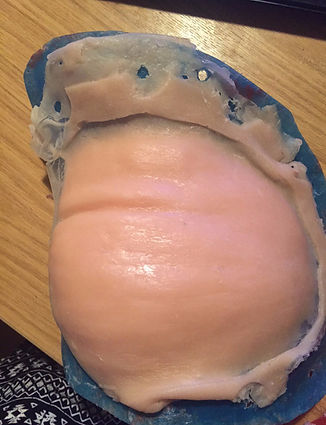Running Silicone
Fatty Hip
A=165
B=165
Deadner=330 (100%)
Total: 660g

Wounded Hip
A=74
B=74
Deadner=103 (70%)
Total: 250g

Using gelatine, I injected the moulds after releasing with vaselaine and Macwax. This was a test run to see how successful the moulds are and to help remove any left over clay.


After releasing the fibreglass with vaseline and Macwax, on both moulds, I did 3-4 layers of cap plastic and IPA on both the core and the mould itself.

The fatty hip on the left is unuseable due to the other side of the prosthetic not filling up properly in the mould. Instead, the silicone escaped out of the lower areas of the mould, leaving an air bubble at the highest point of the piece.
To avoid risk and waste of materials, I will run the larger appliance in gelatine, this way, I can melt it down and re-run the piece again until it iss appliable.

This hip wound appliance wa ssuccessful other than the cap plastic layer. This was because it wasn't released enought for the cap plastic to come out with ease. This may be due to brushing in the cap plastic, where layers may have pulled each other off in the process of layering.
To avoid this next time I run it in silicone, I will spray in the cap plastic and IPA layers using an air pressure container.

When injecting the silicone, I had to block the injection hole whilst I refilled the syringe for the next injections. To avoid this struggle next time, I would use more syringed and pre-fill then prior to injecting. I will also use wing nuts next time as they would be easier to tighten once silicone is on the bolts.
Resolving
When opening my moulds, I hade issues with the cap plastic layer as it had stuck to the fibreglass, which meant it had pulled itself off from the silicone, leaving it un-encapsulated so I couldn't apply and paint this piece. Next time I will spray in the cap plastic beacuse this would reduce any risk of unsettling the cap plastic surface before it is injected.
I will also spray in release so it is a thinner, more accurate layer. This will reduce the risk of any lumps which may affect how the cap plastic dries.
Running wound in silicone
A: 56
B: 56
C: 89 (80%)
Total: 200g
I was originally going to do 200g however, although it is wasteful, I want to ensure this mould fills completely and leaks from all sides, unlike before, this will then ocnfirm that the mould is full and has a larger chance of being successfsul.
Instead i want the total to be 250g.
A: 81
B: 81
C: 89 (65%)
Total: 250g
By brushing in vaseline to release the cap plastic, i was able to get into all the fine detail to ensure it releases with ease from the fibreglass mould. This time I sprayed in the cap plastic so it remains untouched by brushes which may previously have disturbed itslef as layers were built up on top of each other.
This needed a larger measurement to ensure the mould is filled successfully. To ensure this works for the final time, I will use 260g to ensure this mould comepletely fills and creates a successful mould.


Davis, G. & Hall, M. 2012
As an alternative to injecting silicone, a slch mould would give the same results. However, to ensure it is successful, any airbubbles need to be removed by bashing the piece until the air comes to the surface. Once the silicoen is poured in, The flange is bolted together to make the blending edges as thin as possible for application.
Running the Fat Hip in Gelatine
:700g
I used 700g of gelatine pigmented with MAC studio fix foundation: NC35.
This enabled me to re-run the piece if neccessary as I can ment it back down and use it again. I tried to match the silicone pigment with a foundation to pigment the gelatine and NC35 was the best match.


I re-ran a silicone piece for the wounded side, I used a total of 250g to fill my mould as I did before. To resolve the issue of tightening the screws, I used clamps to create a tight mould to enable thin blending edges.
Clamps were the best idea to create fine blending edges, as I had more control over where pressure was being applied, and how close to the blending edge they could be.
A:81
B:81
C:89 (65%)
Total: 250g


